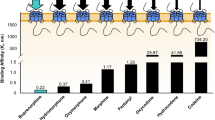The effects of low-affinity NMDA-receptor antagonists amantadine (1-aminoadamantane hydrochloride) and hemantane [N-(2-adamantyl)hexamethyleneimine hydrochloride] on morphine-induced analgesia in C57Bl/6 mice were studied. Amantadine (10 and 20 mg/kg, i.p.) per se did not affect the latent period of the response in the hot-plate test while hemantane (10 and 20 mg/kg, i.p.) increased dose-dependently pain thresholds 180 and 240 min after administration. Morphine (20 mg/kg, s.c.) showed a time—effect dependence (30 – 120 min). The aminoadamantanes were administered 90 min after the opioid to assess their effects on morphine-induced antinociception. The responses of the animals were recorded for the next 2.5 h. The aminoadamantanes potentiated and extended the analgesic activity of morphine in the order of efficacy amantadine < hemantane. The results indicated that the aminoadamantanes had different capabilities to cause delayed analgesia and modulated opioid antinociceptive activity at the supraspinal level.





Similar content being viewed by others
References
M. Suzuki, Curr. Opin. Anaesthesiol., 22(5), 618 – 622 (2009).
G. Hubsher, M. Haider, and M. S. Okun, Neurology, 78(14), 1096 – 1099 (2012).
D. G. Snijdelaar, G. Koren, and G. Katz, Anesthesiology, 100(1), 134 – 141 (2004).
B. Bujak-Gizycka, K. Kacka, M. Suski, et al., Pain Med., 13(3), 459 – 465 (2012).
J. Yazdani, Pain Med., 6(3), e35900 (2016).
E. Kozela, W. Danysz, and P. Popik, Eur. J. Pharmacol., 423(1), 17 – 26 (2001).
D. G. Snijdelaar, C. M. van Rijn, P. Vinken, and T. F. Meert, Pain, 119(1 – 3), 159 – 167 (2005).
D. Malec, M. Mandryk, and S. Fidecka, Pharmacol. Rep., 60(2), 149 – 155 (2008).
Y. Chen, M. Evola, and A. M. Young, Psychopharmacology, 225(1), 187 – 199 (2013).
E. Kozela, A. Pilc, and P. Popik, Psychopharmacology, 165(3), 245 – 251 (2003).
J. E. Grisel, S. Allen, K. V. Nemmani, et al., Pharmacol. Biochem. Behav., 81, 131 – 138 (2005).
I. V. Belozertseva, O. A. Dravolina, O. N. Neznanova, et al., Eur. J. Pharmacol., 396, 77 – 83 (2000).
E. A. Val’dman, Author’s Abstract of a Doctoral Dissertation in Medical Sciences, Moscow (2001).
A. V. Nepoklonov, I. G. Kapitsa, and E. A. Ivanova, Eksp. Klin. Farmakol., 75(11), 3 – 6 (2012).
E. A. Ivanova, I. G. Kapitsa, E. A. Val’dman, and T. A. Voronina, Byull. Eksp. Biol. Med., 159(3), 362 – 365 (2015).
E. V. Katunina, A. V. Petrukhova, G. N. Avakyan, et al., Zh. Nevrol. Psikhiatr. im. S. S. Korsakova, 108(6), 24 – 27 (2008).
E. A. Ivanova, I. G. Kapitsa, A. V. Nepoklonov, et al., Khim.-farm. Zh., 47(10), 12 – 15 (2013).
M. V. Elshanskaya, A. I. Sobolevskii, E. A. Val’dman, and B. I. Khodorov, Eksp. Klin. Farmakol., 64(1), 18 – 21 (2001).
S. S. O’Sullivan, D. R. Williams, D. A. Gallagher, et al., Mov. Disord., 23, 101 – 106 (2008).
A. Q. Rana, A. Kabir, M. Jesudasan, et al., Clin. Neurol. Neurosurg., 115(11), 2313 – 2317 (2013).
I. O. Medvedev, A. A. Malyshkin, I. V. Belozertseva, et al., Neuropharmacology, 47(2), 175 – 183 (2004).
K. E. Redwine and K. A. Trujillo, Pharmacol. Biochem. Behav., 76(2), 361 – 372 (2003).
I. A. Zimin, I. O. Logvinov, T. A. Antipova, and G. I. Kovalev, Eksp. Klin. Farmakol., 74(1), 11 – 14 (2011).
I. O. Logvinov, T. A. Antipova, A. V. Nepoklonov, and E. A. Val’dman, Eksp. Klin. Farmakol., 79(1), 12 – 14 (2016).
M. Suski, B. Bujak-Gizycka, J. Madej, et al., Folia Med. Cracov., 49(3 – 4), 111 – 121 (2008).
Author information
Authors and Affiliations
Corresponding author
Additional information
Translated from Khimiko-Farmatsevticheskii Zhurnal, Vol. 54, No. 4, pp. 15 – 19, April, 2020.
Rights and permissions
About this article
Cite this article
Kolik, L.G., Nadorova, A.V., Chernyakova, I.V. et al. Effects of Aminoadamantane Derivatives on Morphine-Induced Analgesia in Mice. Pharm Chem J 54, 340–344 (2020). https://doi.org/10.1007/s11094-020-02202-1
Received:
Published:
Issue Date:
DOI: https://doi.org/10.1007/s11094-020-02202-1




